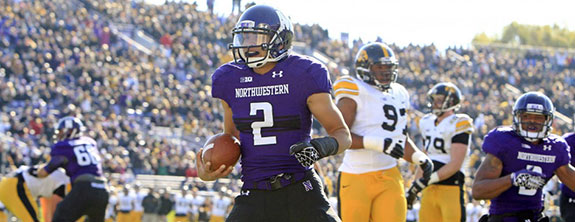
On March 26th, the Chicago regional office of the National Labor Relations Board (“the Board”) agreed that 55 scholarship football players of Northwestern University can be represented by a union for purposes of collective bargaining. The 24 page ruling relies on relevant citations from the National Labor Relations Act as amended. The player’s petition argued grants-in-aid scholarship recipients meet the definition of employees under the act. The University argued the players were students or at best temporary employees not suitable for bargaining.
The Board opinion included an extensive explanation and statement of facts. The scholarship players received $61,000 a year worth of tuition, fees, books, plus room and board in exchange for signing a written document defining their duties and responsibilities. Contracts apply to one year at a time and players can be let go at anytime if they do not play as well as expected or follow the rules. They have to sit out a year to play at another college.
Scholarship players are under strict and exacting control by their employer throughout the calendar year. The work year starts with training camp six weeks before the academic year with the coaches preparing daily hour by hour itineraries that start as early as 5:45 a.m. and go into the evening watching films, after which they are expected to be in bed. Once the season starts activities like practices, meetings, film sessions, workouts and week end games cover 40 to 50 hours per week. There are January workouts, a “winning edge” program in February prior to spring football and summer strength training.
Given the facts cited above the board concluded scholarship players at Northwestern University and by inference the NCAA meet the definition of an employee under the National Labor Relations Act: “a person who performs services for another under a contract of hire, subject to the other’s control or right of control, and in return for payment.” The Regional Board wrote pages of detail describing the work of Northwestern football players to make it difficult to deny their conclusion.
Northwestern and the NCAA oppose the decision. The NCAA frets that a union might harm non-revenue generating sports, especially women’s sports. However, they do not cite athletic department budget figures that would show how much of the football money goes to facilities, coaching salaries and administrative and recruiting costs and how much goes to say, Women’s lacrosse.
The nature of the public discussion implies that players need a lawyer and the government to help them organize a union, but the NLRA rewrites and rewords rights everyone has always had, at least since the ratification of the U.S. Constitution and Bill of Rights. Rights of free speech and free assembly in the first amendment assure the rights to bargain collectively with representatives of our own choosing and the right to withhold work in a strike and to peaceable protest by picketing.
With or without the NLRA it will be hard for Northwestern University Players to organize a union. Players will confront a rich and well-organized cartel, the NCAA. Cartel rules that cap player expenses across many colleges and conferences make their total value enormous relative to a single school like Northwestern University. Organizing at one or a few schools would be easy to defeat; the NCAA would suspend a school violating cartel rules and blacklist the players. The losses would be trivial compared to threats to the cartel. To have a chance of success the union would need to organize many players across many schools. Organizing many would pose a significant financial threat to the cartel, but poses a nearly impossible organizing challenge.
The major league team sports all have unions to represent players, but college sports have more conferences, more teams and more players to organize. Players have only four years of eligibility, which guarantees rapid turnover of players and limits their time to hold out in a labor dispute.
The players could meet together and form their own union if they are unified enough to call for a meeting with coaches and officials to air their grievances. If their grievances are brushed off or ignored they could plan a measured show of solidarity like showing up late for practice before moving on to something more.
Self help organizing may sound quixotic and impracticable, but compare organizing a union under the National Labor Relations Act(NLRA). It requires a long process of filings to the National Labor Relations Board (NLRB) and bureaucratic review to assure the union meets the terms and conditions of the law. The request to the National Labor Relations Board for a ruling on their status as employees barely gets the process started.
Before the National Labor Relations Act labor disputes were private disputes, which often brought nationwide strikes and shutdowns in major industries. For decades employers would claim their employees were happy and contented and did not want a union. Employers were free to dismiss employees for union organizing or union membership. They could impose company union and force employees to join. After the National Labor Relations Legislation in 1935 labor relations became public policy to be administered by public agencies with legally defined powers over unions and a strong desire to prevent strikes and shut downs.
When employees or union organizers attempt to establish a union, the National Labor Relations Act requires management to bargain in good faith, but bargaining in good faith has been hard to define much less enforce. Hence the procedure of enforcement has tried to define good faith through hearings at the National Labor Relations Board to settle disputes.
Good faith obligates both sides to meet and make an honest effort to keep an open mind and settle differences, but the two sides only have to try to reach an agreement. After decades of hearings and written opinions good faith requires a little more than going through the motions of sitting and talking or holding an initial position indefinitely. Despite years of rulings good faith, or not, rests on inference based on the mood or apparent state of mind of the parties.
The only help the Northwestern University football players will get from American labor law is a governmental interpretation of good faith bargaining. The National Labor Relations Act does not limit management rights, does not require agreements to end strikes or grievances; does not keep employers from hiring replacement workers; and does not limit management powers to discipline or control employees. Failure to act in good faith by an employer is an unfair labor practice, but there are no penalties for acting in bad faith. After hearings and delay the National labor Relations Board can order employers to follow the law and they can order back pay for those dismissed for union organizing, but there is little to deter more subtle forms of anti union actions.
As the matter stands the players have already voted, yes or no, to have a union. The results are not released as of this writing, May 14, 2013, pending a review and decision by the Washington office of the National Labor Relations Board.
The crude and heavy-handed exploitation of players in college football and basketball remains. In the major league team sports players have fought restrictions on their rights of free agency, but unlike college sports there was never an absolute dollar cap on their salaries. College players get their tuition and room and board and nothing else. The earnings from college are so high that independent commercial interests might organize a minor league for players ages 18 to 24 as a way to battle the NCAA. Generally a large commercial interest like the NCAA has to be challenged by another large commercial interest to bring some reforms. What happens after the Washington Labor Board’s decision will be fun to watch, but do not expect a union to result.
 About the author: Fred Siegmund covers America's jobs as part of work doing labor market analysis and projections for a client base of recruiters, trainers and counselors. Visit him at www.americanjobmarket.blogspot.com
About the author: Fred Siegmund covers America's jobs as part of work doing labor market analysis and projections for a client base of recruiters, trainers and counselors. Visit him at www.americanjobmarket.blogspot.com



